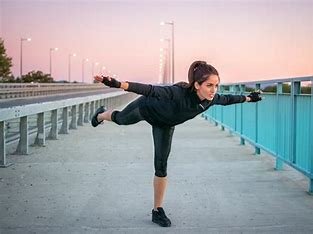
🦵 Single-Leg Stands
How It Works:
- The single-leg stand challenges your ability to balance on one leg, forcing your body to engage various stabilizer muscles around your ankles, knees, hips, and core.
- This exercise promotes proprioception and engages small muscles that are often overlooked, particularly those around the ankle and hip.
Benefits:
- Improves balance: Enhances your ability to stabilize and control body movements in real life, especially when navigating uneven terrain.
- Core engagement: Requires your core muscles to work hard to keep you upright and stable.
- Strengthens stabilizer muscles: Helps with muscle coordination and balance, improving joint function.
- Injury prevention: Reduces the likelihood of ankle sprains or knee instability by strengthening supportive muscles.
How to Perform:
- Stand with your feet shoulder-width apart.
- Slowly shift your weight onto one leg, lifting the other leg off the ground.
- Hold the position for 20-30 seconds, aiming to stay steady without holding onto anything.
- Switch legs and repeat.
Progression:
- Close your eyes to challenge your balance further.
- Add a slight bend in your standing leg to make the exercise more difficult.
🏄 Balance Board Workouts (BOSU Ball or Balance Boards)
How It Works:
- Balance boards (or BOSU balls) create an unstable surface that forces your body to make constant micro-adjustments to stay balanced.
- The board or ball engages your core and leg muscles as your body tries to stabilize itself.
Benefits:
- Engages deep core muscles: The instability requires your core muscles (including the obliques and transverse abdominis) to stabilize your spine and keep you upright.
- Improves reaction time and coordination: Enhances the body’s ability to respond quickly to changes in posture and movement.
- Strengthens ankle and knee stability: Helps prevent injuries by improving joint stabilization and coordination.
- Increases proprioception: Teaches your body to be more aware of its position and how to adjust when balance is compromised.
How to Perform:
- Place one foot on the center of the balance board or BOSU ball.
- Gradually shift your weight onto the board and find your center of balance.
- Hold for 20-30 seconds, focusing on engaging your core and keeping your posture stable.
- Challenge yourself by adding simple movements like squats, reaching with arms, or tilting the board side-to-side.
Progression:
- Add squats while on the balance board to increase difficulty.
- Try balancing with your eyes closed for an added challenge.
⚽ Stability Ball Exercises (Swiss Ball)
How It Works:
- Stability balls are fantastic tools for improving balance because they force your body to engage multiple muscle groups at once, especially your core and lower body.
- When you perform exercises on the stability ball, your body needs to maintain balance while performing movements like squats, planks, or crunches.
Benefits:
- Core strengthening: The instability of the ball forces the core muscles to contract to stabilize the body.
- Improves coordination: Your brain has to work harder to control the movements on the ball, which enhances motor skills and balance.
- Increases flexibility and mobility: Helps stretch and lengthen muscles during exercises like stability ball stretches.
- Reduces injury risk: Strengthens muscles and stabilizers around the spine, improving posture and reducing the risk of back pain.
How to Perform:
- Stability Ball Squats:
- Stand with your back against the stability ball, placing it between your lower back and a wall.
- Slowly squat down while keeping your knees behind your toes. The ball should roll up and down your back as you squat.
- Perform 10-15 squats, ensuring your core stays engaged to stabilize your body.
- Plank on Stability Ball:
- Place your forearms on the ball, ensuring that your feet are shoulder-width apart.
- Hold your body in a straight line from head to heels, engaging your core muscles to maintain stability.
- Hold for 20-30 seconds, gradually increasing the time as your balance improves.
Progression:
- Try performing push-ups or leg lifts while balancing on the ball for more advanced core work.
- Perform exercises with one leg on the ball for an added challenge.
🌟 Why These Exercises Work
1. Core Engagement
- These exercises activate deep core muscles (such as the transverse abdominis and multifidus), which are responsible for stabilizing your spine and maintaining posture.
- A strong core allows you to stabilize the rest of your body, improving your overall balance and reducing strain on your back and joints.
2. Improved Proprioception
- By forcing you to balance in different positions, these exercises enhance your proprioceptive ability—your awareness of your body’s position in space.
- This is key for everyday activities, especially navigating challenging environments (uneven ground, stairs) and for athletic movements that require quick shifts in direction.
3. Enhanced Coordination
- Balance training improves your body’s ability to coordinate movements across multiple joints (hips, knees, ankles) and muscles (core, legs, and stabilizers).
- This is beneficial for sports performance, injury prevention, and even activities like dancing or martial arts.
🔑 Incorporating Balance Training Into Your Routine
How Often Should You Train Balance?
- Start by including balance exercises 2–3 times a week.
- If you’re a beginner, perform exercises for 15-20 minutes.
- As your strength and balance improve, gradually add more time or difficulty to your routine.
Sample Balance Routine:
- Single-Leg Stand: 2 sets of 30 seconds each leg.
- Balance Board: 2 sets of 30 seconds.
- Stability Ball Squats: 2 sets of 12-15 reps.
- Plank on Stability Ball: Hold for 20–30 seconds, 3 sets.
Balance and stability exercises are essential for building a stronger, more resilient body. They not only help you move better and perform better, but also significantly reduce the risk of injury, especially as you age or take on more physically demanding activities.
